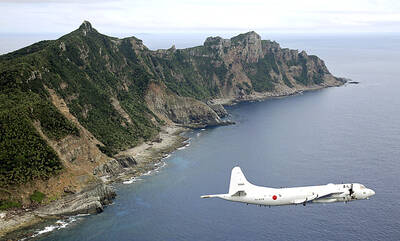The nation’s export orders last month grew 9.9 percent year-on-year to a record high US$50.03 billion, backed by rising demand for smartphones and 5G-related gadgets, as well as chips used in the devices, the Ministry of Economic Affairs (MOEA) said yesterday.
It was the seventh consecutive month of annual growth, and the ministry forecast that export orders would climb to between US$51.5 billion and US$53 billion this month, an increase of 8.9 percent to 12.1 percent year-on-year.
“Export orders were better than expected across all categories,” Department of Statistics Director Huang Yu-ling (黃于玲) said.

Photo: Ann Wang, Reuters
Growth in the electronic products sector was “especially notable,” Huang said, adding that the traditional sectors worst hit by the COVID-19 pandemic were “recovering.”
Orders for electronic products grew 29.7 percent year-on-year and 14.5 percent month-on-month to US$16.1 billion due to sustained strong demand for work-from-home equipment, 5G applications and high-performance computing equipment, she said.
However, Huawei Technologies Co (華為) stockpiling chips before US sanctions took effect on Sept. 15 was also a factor, she added.
Orders for optical equipment were up 19.6 percent year-on-year to US$2.4 billion on work-from-home, distance-learning and entertainment-at-home demand, she said.
Orders for the information and communications technology sector fell 9.6 percent year-on-year to US$13.9 billion due to the delayed launch of “a smartphone product by an international company,” Huang said.
Orders for base metal products arrested six straight months of year-on-year contraction, growing 14.8 percent year-on-year to US$2.2 billion.
Plastic product orders also returned to growth, increasing 13.9 percent year-on-year to US$2 billion, while those for chemical products fell 2.6 percent to US$1.4 billion, but the decline was mild compared with the double-digit percentage decreases in the previous six months.
Orders for mechanical products grew 23.7 percent year-on-year to US$1.9 billion, “as more countries allocate production back home,” the ministry said in a statement.
The percentage of products made in Taiwan last month increased to 46 percent from 42.7 percent in September last year, ministry data showed.
The increase reflects a trend to decentralize production, Huang said.
“China used to be the world’s factory, but we are seeing a trend to move production to other countries as a risk mitigation measure,” she said. “We expect to see this trend continue.”
Although export orders last month grew by 9.9 percent when calculated in US dollars, the growth was only 3.6 percent when calculated in New Taiwan dollars, due to the local currency’s appreciation.
Small and medium-sized enterprises would likely to be most hurt when the strength of the local currency begins to affect the competitiveness, Huang said.
“Large manufacturers are more likely to be price-setters in their industry and are insulated against fluctuating exchange rates through risk mitigation measures,” she said.
Overall, export orders in the third quarter grew 11.9 percent year-on-year to US$141.1 billion, while in the first three quarters of the year they rose 4.2 percent year-on-year to US$363.7 billion, ministry data showed.

MISINFORMATION: The generated content tends to adopt China’s official stance, such as ‘Taiwan is currently governed by the Chinese central government,’ the NSB said Five China-developed artificial intelligence (AI) language models exhibit cybersecurity risks and content biases, an inspection conducted by the National Security Bureau (NSB) showed. The five AI tools are: DeepSeek, Doubao (豆包), Yiyan (文心一言), Tongyi (通義千問) and Yuanbao (騰訊元寶), the bureau said, advising people to remain vigilant to protect personal data privacy and corporate business secrets. The NSB said it, in accordance with the National Intelligence Services Act (國家情報工作法), has reviewed international cybersecurity reports and intelligence, and coordinated with the Ministry of Justice Investigation Bureau and the National Police Agency’s Criminal Investigation Bureau to conduct an inspection of China-made AI language

LIMITS: While China increases military pressure on Taiwan and expands its use of cognitive warfare, it is unwilling to target tech supply chains, the report said US and Taiwan military officials have warned that the Chinese People’s Liberation Army (PLA) could implement a blockade within “a matter of hours” and need only “minimal conversion time” prior to an attack on Taiwan, a report released on Tuesday by the US Senate’s China Economic and Security Review Commission said. “While there is no indication that China is planning an imminent attack, the United States and its allies and partners can no longer assume that a Taiwan contingency is a distant possibility for which they would have ample time to prepare,” it said. The commission made the comments in its annual

‘TROUBLEMAKER’: Most countries believe that it is China — rather than Taiwan — that is undermining regional peace and stability with its coercive tactics, the president said China should restrain itself and refrain from being a troublemaker that sabotages peace and stability in the Indo-Pacific region, President William Lai (賴清德) said yesterday. Lai made the remarks after China Coast Guard vessels sailed into disputed waters off the Senkaku Islands — known as the Diaoyutai Islands (釣魚台) in Taiwan — following a remark Japanese Prime Minister Sanae Takaichi made regarding Taiwan. Takaichi during a parliamentary session on Nov. 7 said that a “Taiwan contingency” involving a Chinese naval blockade could qualify as a “survival-threatening situation” for Japan, and trigger Tokyo’s deployment of its military for defense. Asked about the escalating tensions

DISPUTE: A Chinese official prompted a formal protest from Tokyo by saying that ‘the dirty head that sticks itself out must be cut off,’ after Takaichi’s Taiwan remarks Four armed China Coast Guard vessels yesterday morning sailed through disputed waters controlled by Japan, amid a diplomatic spat following Japanese Prime Minister Sanae Takaichi’s comments on Taiwan. The four ships sailed around the Senkaku Islands — known as the Diaoyutai Islands (釣魚台) to Taiwan, and which Taiwan and China also claim — on Saturday before entering Japanese waters yesterday and left, the Japan Coast Guard said. The China Coast Guard said in a statement that it carried out a “rights enforcement patrol” through the waters and that it was a lawful operation. As of the end of last month,